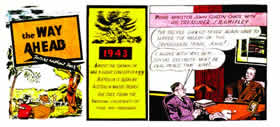INTERPRETATION ACTIVITY ON THE ECONOMY
You can find the answers to all these questions in The Economy display panels of the online exhibition John Curtin's Legacy: Leading Australia from war to peace.
When you have completed the activity, you can check your answers using the online Answer Key.
1. What were the main features of the National Economic Plan?
2. How did the Federal Government persuade the States to give up their income tax collecting powers during the war?
3. What evidence is there that not every State was happy to pass this taxation power over to the Federal Government.
4. What long term changes occurred in banking as a result of the war?
5. What was the key principle on which Australia's post-war reconstruction was based?
6. What school of economic thought did the Curtin Government follow in its White Paper of 1945?
7. Study this photograph from the exhibition showing the Commonwealth Bank in Forrest Place, Perth, taken about 1950. (You can click on the photograph to see a larger image.)
a. How is banking today different from what you can see in this picture?
b. Are there any ways in which banking today is similar to what you can see in the picture?
Banking Hall, Commonwealth Bank Forest Place Perth 1950. Battye Library: 008208D
8. In 'the WAY AHEAD' cartoon, what does John Curtin say will be Labor's peace time aim? (You can click on the cartoon to see a larger image.)
‘1946 Repeats Itself – Chifley Spells Security’ comic strip. Battye Library: MN 300, 1719A/20/14.
9. When did planning begin for the post-war period?
10. How did the Commonwealth Government gain dominance in finance and taxation?
11. What power did 'tied grants' give the Commonwealth Government?
12. What does the exhibition suggest is the most enduring legacy of the Curtin and Chifley Governments?
13. What changes to government powers were ratified by the referendum of 1946?
14. List at least four of the welfare provisions that were available to Australians by the end of the 1940s.
15. The Curtin and Chifley Governments paved the way for Commonwealth involvement in a number of key areas. Name at least three of these.
Check how you went by comparing your answers with our Answer Key. l Online Activities Home Page

